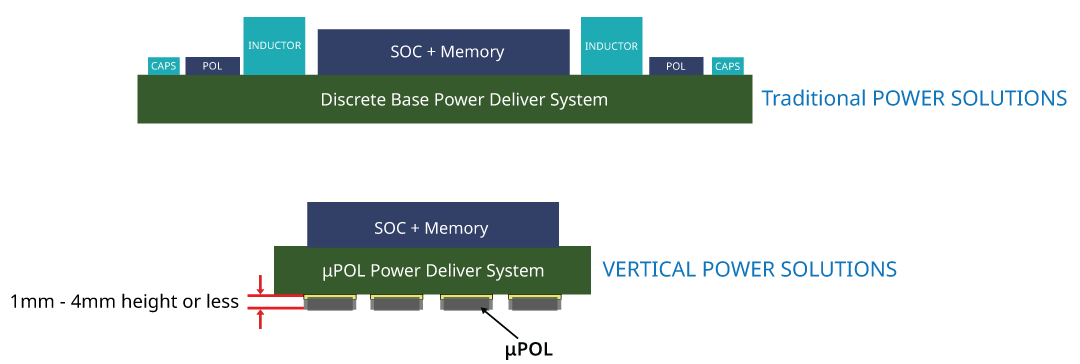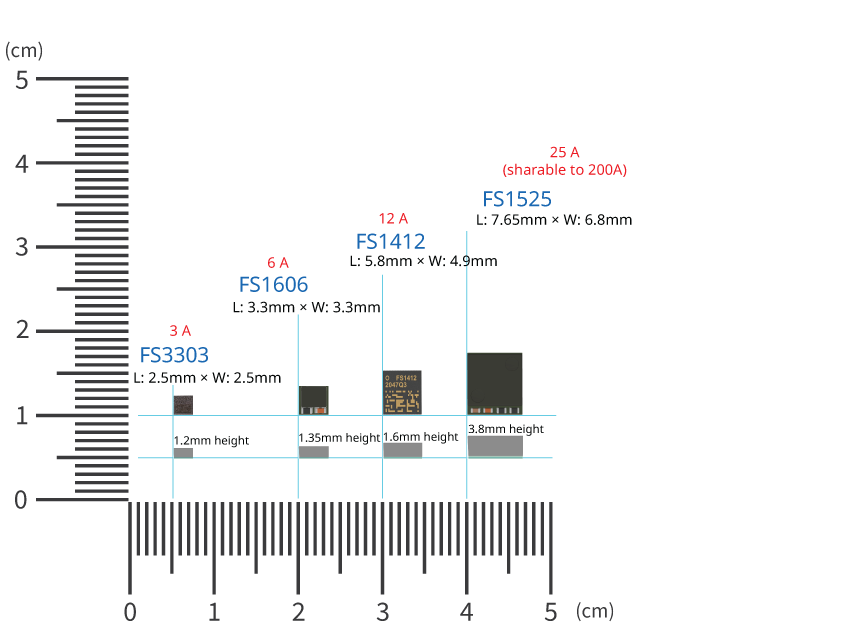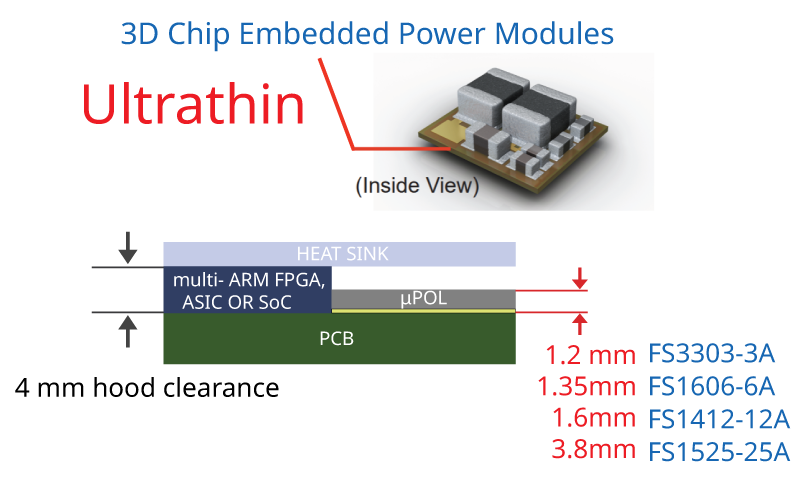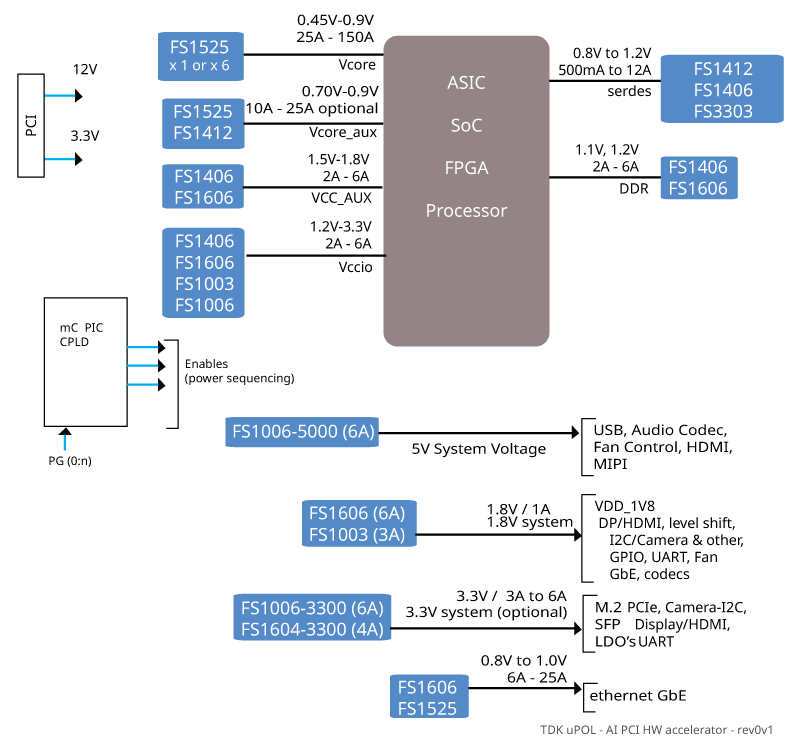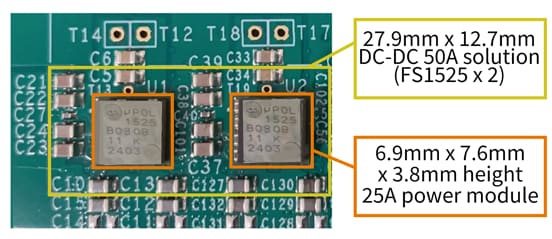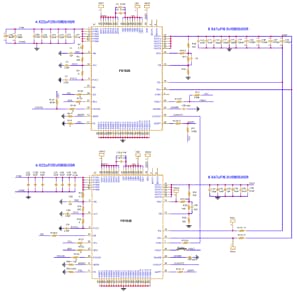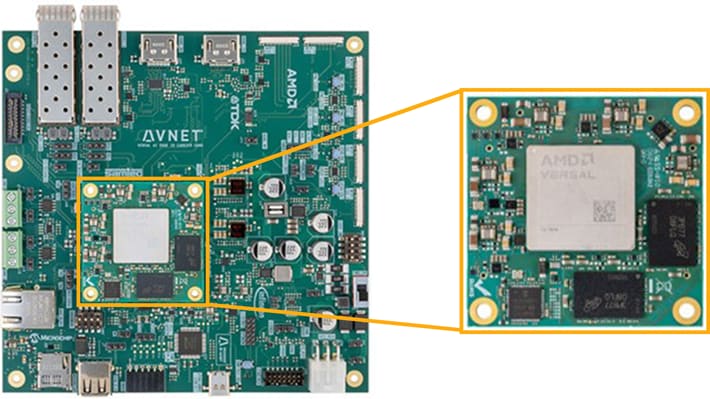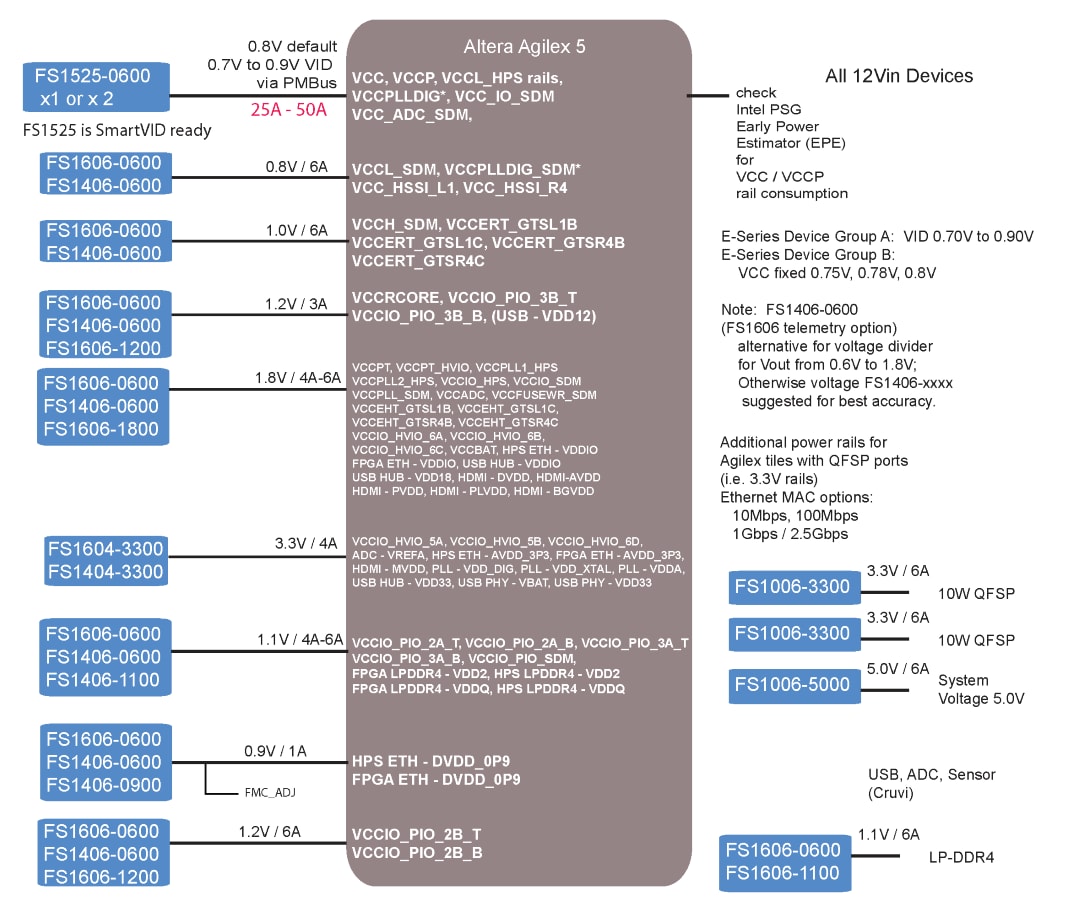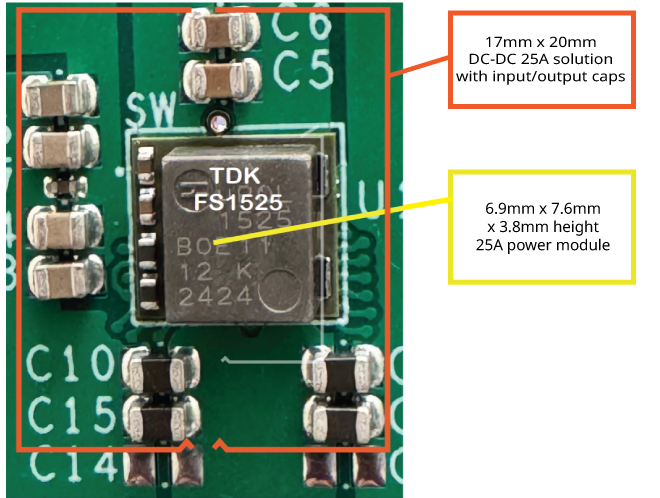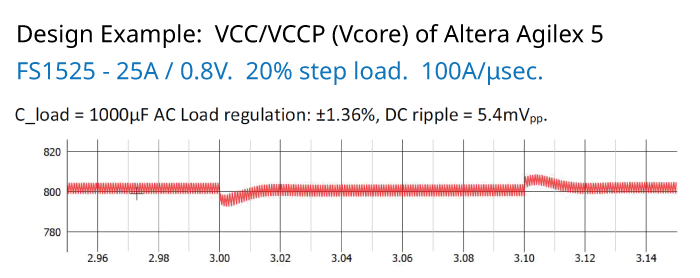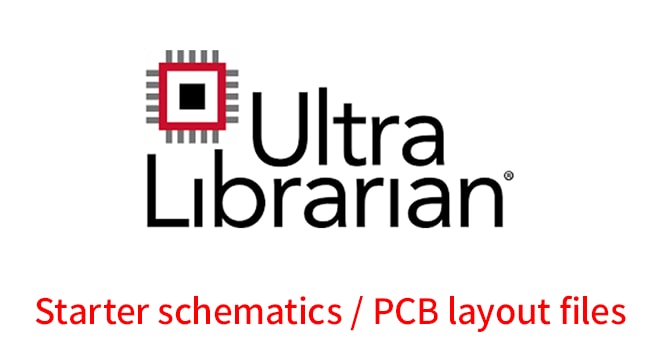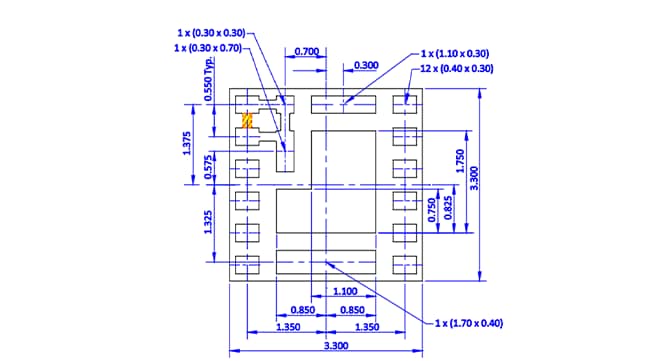Next-Generation Vertical Power Design for Compact and High-Performance FPGA, SoC, and ASIC

Need for Vertical Power
With the increase of computing power for AI and broadband edge communications, the new processors, ASICs and FPGAs/SoCs is driving the need for DC-DC power delivery into tighter board space design and SoC power integration. TDK's μPOL DC-DC converters that feature a chip-embedded technology (Semiconductor Embedded in SUBstrate - SESUB) to achieve best in compact size, matches ideally with vertical power supplies from 1A to 200A for these applications. Total vertical power solutions are now expanding to core voltage, auxiliary voltage, bus voltage, and high speed serializers chip voltages. Figure 1 provides a high-level example using chip embedded technology to achieve scalable vertical power solutions. Transform your traditional discrete base power delivery system into an optimized vertical power design with TDK's μPOL.
Good examples for the need of vertical power and high density solutions can be seen in PCIe hardware accelerators and FPGA SoM (system on modules) designs today. The new chip embedded solutions for DC-DC are now in practical power density delivery from 100A/cm3 to 500A/cm3 and higher (Figure 2). Shown is best in class solutions for power density for vertical power delivery from 1A to 200A.
| μPOL | Power Density | Watts |
|---|---|---|
| FS1525 | 127 A/cm3 | 45W/25A |
| FS1412 | 263 A/cm3 | 21W/12A |
| FS1606 | 408 A/cm3 | 15W/6A |
| FS3303 | 400 A/cm3 | 9.9W/3A |
TDK μPOL Enables Compact Design and Optimal Thermal Management
Total design integration to combine the power IC, the inductor, Boot capacitor, packaging substrate provides a complete DC-DC solution for vertical power delivery (Figure 3). By integrating the inductor, the PCB footprint in the planar dimension is reduced, while achieving a low profile that can be implemented in spaces from 1.2mm to less than 4mm.
The power IC die includes the MosFETs and driver and is encapsulated into the layers of chip embedded substrate packaging (SeSUB), thus eliminating the wire bonds and minimizing inter-connects to avoid unnecessary power losses. In addition, the use of copper re-distribution layers onto the die and connecting to fine copper vias between the layers to the pins of the package provides significant heat release from the chip to the PCB board. For a detailed visual explanation of the chip embedded integration, including the FS1412 construction as an example, click the button below to watch the video.
AI and Edge applications examples
Figure 4 depicts a general power block diagram of a PCIe Hardware Accelerator Cards. The processor can be an ASIC, SoC or FPGA with the addition of communications interface fabric and other bus I/O. Within the PCIe input power budget can range a 75W to 150W power sub-system. The largest current consumption coming from the Vcore rail of the processor, ranging today from 0.45V to 0.9V, and 25A to 150A. The total power solution can consist of 5 to 15 POL devices. In addition, more POL power maybe needed for added peripheral functions such as USB, Audio Codecs, Video interfaces and ethernet GbE ports. Hence the need for compact power design for the limited PCB board space.
An example of TDK μPOL power solutions for AI Hardware accelerator cards are shown below in Figures 5 and 6. Figure 5 shows at total solution for 50A using two FS1525 in parallel with input and output capacitors in only a space of 27.9mm x 12.7mm. The FS1525 is scalable to 8 phase to serve Vcore from 25A to 200A. This includes excellent transient response from 10A/us to 200A/us+ to meet the need of the new FPGAs, ASICs and SoCs. And Vout accuracies of +/-1% DC and less than +/-3% AC. This is achieved with an inherent and internal 2-phase (2-inductor) design, per power module with an effective higher frequency of operation from 1MHz to 16MHz. The internal regulator design is state of the art and also reduces the number of external load components. This solution can be used to fit under heat sinks and encapsulated processor or FPGA hoods under 4mm. The FS1525 has a height of only 3.8mm for the complete power module construction. This enables vertical power design to bring the POL devices closer to the target load on either the top-side or bottom-side of the PCIe board or similar tight form factors such as 1U to 3U or SoMs (system on modules). Figure 6 shows the high integration of minimum external components of the FS1525 for a typical schematic of a 50A power solution. Two FS1525 are shown in a current sharing mode to deliver 50A.
Table 1 below provides an example for scalable vertical power delivery for various AI SoC/FPGA and ASICs and Edge SoC from 25A to 200A.
| TDK μPOL DC-DC | Vcore | FPGA/SoC, ASIC, Edge Devices |
|---|---|---|
| FS1525 - 15A to 200A FS1412 - 6A to 12A FS1606 - 1A to 6A FS1003 - 1A to 3A FS3303 - 500mA to 3A FS1006, 6A (3.3V/5.0V) |
0.7V 25A to 150A |
AMD Xilinx - Versal, Virtex |
| 0.45V-0.8V 25A to 150A |
Other AI RISC V SoCs | |
| 0.7V-0.9V 25A to 150A |
Altera Agilex | |
| 0.8V 25A to 40A |
Broadcom - NetXtreme BCM | |
| 0.8V 15A - 20A |
Other GbE ASICs (10G to 40G) |
Highlights and Advantages of TDK μPOL
Below is the summary of the advantages of TDK solutions for DC-DC in general. This can be applied to several applications:
Best in compact DC-DC power modules
- size, height
- integration, least amount of BoM (minimized external components)
- ease of design – simple schematics and PCB layout, Spice and Simplis tools
Excellent robust design
- Best thermal performance for size with no airflow
- -40C to +125C
Scalable power design
- 1A to 200A power modules for complete DC-DC power solutions
- 0.4V to 5V output
- Advanced power: telemetry, fault setting and control, Vout setting on I2C/PMBus
- Adding more devices to expand the portfolio breadth
Sustainability
- Long-term availability 10-15+ years
- Pin compatibility from multiple sources
TDK Power Reference Designs for AI and Edge applications.
TDK has several designs in production with key processors, FPGA/SoCs and special AI ASICs. Some of these are available on TDK websites and partner websites. Below is a listing of the designs.
TDK μPOL with AMD Versal
Available in Q1’2025 is the Avnet AMD-Xilinx Versal Edge reference design platform. The starter schematics and Simplis design libraries are available on TDK site. This design will be for AMD’s VersalTM Edge, VE2302, an AI SoC/FPGA. Featured on this design is TDK’s FS1525 (50A) and FS1406 (1A to 6A) for tight power designs on SOM and Carrier board. Figure 7 shows the upcoming reference design platform. Applications: Artificial intelligence, machine learning, edge computing, edge sensors (radar, LiDAR), robotics. Avnet information and availability will be on site at avnet.com.
TDK μPOL with Altera Agilex
AgilexTM FPGA/SoC is excellent for Edge applications with integrated GbE capabilities. Planned availability of the reference design is early 2025 for Agilex 5 with Arrow and Altera. This design will feature FS1525 (25A) and FS1606 (1A to 6A) and other TDK μPOL devices for a complete power design with Agilex 5. The FS1525 is SmartVID ready and is capable of scalable Vcore power on SmartVID from 25A to 200A and capable of communication with Intel Altera’s Quartus/SDM control on PMBus. In addition, the FS1006-3300 (3.3V) is also ideal for the edge communication applications to support Altera’s Agilex for the QSFP Gigabit ethernet up to 10 Watts from 10 Mbps to 2.5Gbps. Starter schematics and Simplis design libraries are available on TDK site for Altera’s Agilex series including Agilex 7 and Agilex 5. More information will be available on this design in Q1’2025. Figure 8 below is the example of the power solution for Agilex 5 including power options for the various Agilex chiplet options and voltage rail consolidations to optimize the minimum number of POL devices. TDK μPOL delivers best in size and power density for Agilex 5, see Figure 9. Figure 9 shows FS1525 for the VCC (Vcore) for Agilex 5, 25A in 6.8mm x 7.6mm x 3.8mm height, power module with integrated inductor. Figure 10 provides performance of the design to meet the low voltage ripple and transient response for the Vcore rails using the FS1525 for Agilex 5.
TDK Power Reference for Various Embedded Processors, FPGA/SoCs, & ASICs applications
Table 2 below provides a quick reference guide for low end, mid-range and high end embedded processors, FPGAs/ASICs, Edge GbE devices. It provides a quick DC-DC reference for TDK μPOL devices from DC-DC solutions from 5W to 200W+. All of these devices and similar need DC-DC precision regulation. If you would like to know more detailed information regarding the reference, including schematics, please download the materials from the form below to assist in your design.
| Low End | Mid-range | High End | |||||
|---|---|---|---|---|---|---|---|
| Embedded Control | ARM MO-M4 Atmel Microsemi |
AMD-Xilinx Zynq 7 Altera Cyclone,Agilex 3 Sundance NXP i.Mx8 Nvidia Jetson Orin |
AMD-Xilinx Zynq 7 AMD-Xilinx Zynq US+ Microsemi Polarfire Lattice Avant-E NXP i.Mx8 Efinix Microsemi |
AMD-Xilinx Zynq US+ AMD-Xilinx RFSOC Microsemi Polarfire AMD-Xilinx Kintex US+ Altera Arria 10 Altera Agilex 5 Cavium Octeon Broadcomm / Marvell NXP QorlQ Other SoCs: Nvidia Xavier Jetson Esperanto Tech TI Sitara or Similar Mobile Eye ADAS ASICs Server/Al Accelerator ASICs Multi-ARM A5x SoCs |
Altera Arria 10/ Stratix 10 Altera Agilex 7/9 AMD-Xilinx Virtex AMD-Xilinx Versal NXP QorlQ Cavium Octeon Other SoCs: Nvidia Esperanto Tech Groq Mobile Eye ADAS ASICs Multi-ARM A5x SoCs Server/Al Accelerator ASICs |
Altera Arria 10 / Stratix 10 Altera Agilex AMD-Xilinx Versal Al AMD-Xilinx Virtex US+ |
|
| DC-DC | <5W to 10W | 10W+ | 10W to 20W | 15W to 30W | 25W to 50W | 50W to 200W+ | |
| TDK Power | 25~200A | FS1525 | FS1525 | FS1525 | |||
| 12A | FS1412 | FS1412 | FS1412 | FS1412 | |||
| ~6A | FS1403, FS1003, FS1606, FS1006, FS1703, FS3303 | FS1406, FS1606, FS1404, FS1403, FS1006, FS1003, FS1703, FS3303 | FS1406, FS1606, FS1404, FS1003, FS1603, FS1604, FS1006, FS3303 | FS1606, FS1604, FS1603, FS1003, FS1006, FS3303 | FS1606, FS1604, FS1603, FS1003, FS1006, FS3303 | FS1606, FS1604, FS1603, FS1003, FS1006, FS3303 | |
Registered Trademarks:TDK μPOL is a registered by TDK, Agilex is registered by Intel / Altera, Versal is registered by AMD / Xilinx, QSPICE is registered by Qorvo
See Power Reference with Schematic
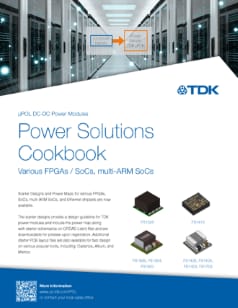
TDKuPOLPowerSolutions
ValueCreation_F1_microPOL

